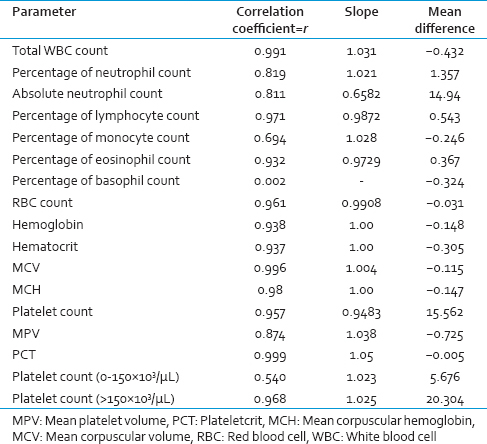Translate this page into:
Comparison of Complete Blood Count Parameters between Venous and Capillary Blood in Oncology Patients
Address for correspondence: Dr. Preeti Chavan, E-mail: pchavan@actrec.gov.in
This is an open access article distributed under the terms of the Creative Commons Attribution NonCommercial ShareAlike 3.0 License, which allows others to remix, tweak, and build upon the work non commercially, as long as the author is credited and the new creations are licensed under the identical terms.
This article was originally published by Medknow Publications & Media Pvt Ltd and was migrated to Scientific Scholar after the change of Publisher.
Sir,
Complete blood count (CBC) is one of the very important basic laboratory investigations in any clinical setting on which many clinical decisions are based. Venous blood is generally collected for majority of routine laboratory tests. However, in certain situations where it is not feasible to obtain venous blood, finger prick or capillary blood samples can be an alternative and comparable option.
We collected venous and capillary blood samples from 219 adult cancer patients (M: 156, F: 63) who visited our outpatient department for their routine follow-up. They were undergoing various stages of treatment, for example, postsurgery, postbone marrow transplant, undergoing chemotherapy or radiotherapy, etc., and were chosen in random order. A written consent was obtained from all subjects who participated in the study. Both types of samples, i.e., venous and capillary blood samples were collected at the same time from the patients in our blood sample collection area by trained phlebotomists.
Capillary blood samples were collected by the finger prick method in mini containers with ethylenediaminetetraacetic acid (EDTA) (MiniCollect by Greiner Bio-One International GmbH, Austria) assigned for collection of small volumes of blood. Care was taken to mix blood sample well with EDTA upon collection. For venous collection, blood was collected in K2 EDTA 3 ml tube (IMPORVE by Guangzhou Improve Medical Instruments, Guangdong, China) according to standard venous blood collection protocol using vacutainer system. Both sets of samples were processed in HMX 5-part differential analyzer by BeckmanCoulter, Inc.
The results were compared for hemoglobin (Hb), white blood cell (WBC) parameters (total count, %neutrophils, %monocyte, %lymphocytes, %eosinophils, %basophils, and absolute neutrophil count [ANC]), red blood cell (RBC) parameters (RBC count, mean corpuscular volume [MCV], mean corpuscular Hb [MCH], MCH concentration [MCHC], hematocrit [HCT], and RBC distribution width), and platelet parameters (platelet count, plateletcrit, and platelet distribution width) and were analyzed using Passing-Bablok regression analysis and Bland-Altman analysis for systemic bias, if any.
In our study, the total WBC count, differential leukocyte count in percent (neutrophil, lymphocyte, monocyte, and eosinophil), total RBC count, and other RBC parameters (MCV, MCH, MCHC, HCT) correlated well and showed no clinically significant mean difference [Table 1]. This correlates with the findings of Kim et al.[1] which reported a high coefficient (r) correlation for WBC, RBC, and platelets. Another study by Schalk et al.[2] which studied 447 blood samples found no difference in the ANC between the two sample sets, which correlates with the findings in our study where a good correlation (r = 0.811) was observed for ANC. However, Daae et al.[3] concluded that WBC count, red cell count, Hb, and HCT were significantly higher in capillary samples, platelet count in adult samples was either identical or considerably higher in venous blood samples and red cell indices (MCV, MCH, and MCHC) were identical in the two sets of samples. The Hb value was higher in capillary blood in the study by Kayiran et al.[4] In our study, for the platelet count in thrombocytopenic patients (venous platelet count 0–150 × 103/μL), the mean difference was 5.676, while the same for patients with platelet count >150 × 103/μL was much higher at 20.304. Thus, the comparability of platelet counts was better in thrombocytopenic patients compared to those with higher platelet counts. This can be attributed to the aggregation of platelets in capillary blood samples[5] with higher platelet counts. In our study, except for basophil count, the rest of the differential leukocyte count correlated well between capillary and venous samples.

Our study suggests that capillary samples may be used as a substitute for venous samples for general parameters such as Hb, leukocyte, and red cell counts; however, for platelet counts higher than 150 × 103/μL, false low counts are observed in capillary samples, thereby limiting its utility.
Financial support and sponsorship
Nil.
Conflicts of interest
There are no conflicts of interest.
REFERENCES
- Comparison of blood counts in capillary and venous blood in children. Korean J Hematol. 2009;44:237-43.
- [Google Scholar]
- Correlation of capillary and venous absolute neutrophil counts in adult hematological patients and normal controls. Am J Hematol. 2008;83:605.
- [Google Scholar]
- A comparison between haematological parameters in 'capillary' and venous blood samples from hospitalized children aged 3 months to 14 years. Scand J Clin Lab Invest. 1991;51:651-4.
- [Google Scholar]
- Significant differences between capillary and venous complete blood counts in the neonatal period. Clin Lab Haematol. 2003;25:9-16.
- [Google Scholar]
- Dacie and Lewis Practical Haematology (9th ed). London, UK: Churchil Livingstone, Elsevier Ltd; 2001. p. :1:4.




